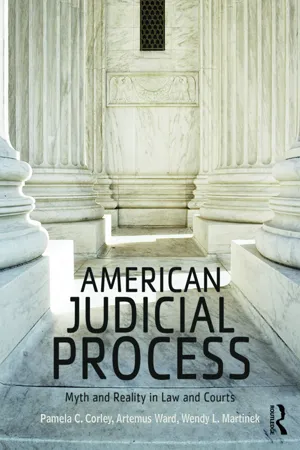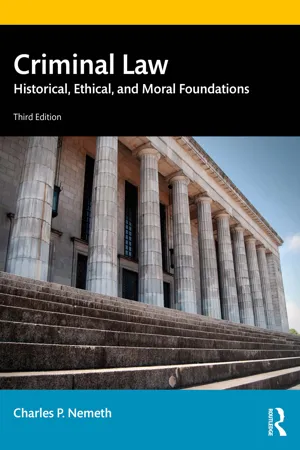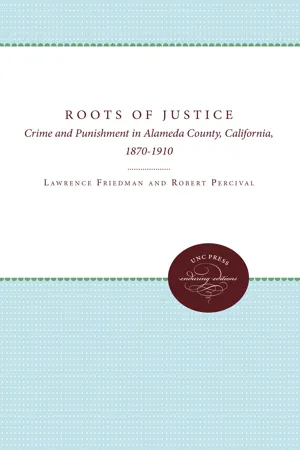Law
Felonies
Felonies are serious crimes that are punishable by imprisonment for more than one year. Examples of felonies include murder, rape, robbery, and drug trafficking. Felonies are considered more severe than misdemeanors and can result in significant legal consequences.
Written by Perlego with AI-assistance
Related key terms
5 Key excerpts on "Felonies"
- eBook - ePub
American Judicial Process
Myth and Reality in Law and Courts
- Pamela C. Corley, Artemus Ward, Wendy L. Martinek(Authors)
- 2015(Publication Date)
- Routledge(Publisher)
They can also include white-collar crimes 88 (such as embezzlement and insider trading) and fraud schemes (such as bank fraud and credit card fraud). Second or third offenses that would otherwise be misdemeanors can be elevated to Felonies. So, for example, in the state of Texas a first or second DWI offense is considered a misdemeanor while a third such offense is considered a felony. Punishments for Felonies include prison sentences from 1 year to life without parole and, for the most serious Felonies such as murder, even the death penalty. 89 Defendants are entitled to a jury trial and a court-appointed attorney, though this was not always the case for state crimes. The U.S. Supreme Court had previously held that the right to counsel was crucial when a defendant was charged with a capital crime (that is, a crime for which the death penalty could be imposed), 90 however, it did not extend the right to counsel for state Felonies until the well-known case of Gideon v. Wainwright. 91 The story behind Gideon was recounted in the best-selling book Gideon’s Trumpet 92 and subsequently adapted for a made-for-television movie of the same name starring acclaimed actor Henry Fonda (father of Jane and Peter Fonda and grandfather of Bridget Fonda). Examples of Felonies include murder, rape, assault, battery, and arson. As these distinctions among infractions, misdemeanors, and Felonies demonstrate, contemporary society categorizes crime seriousness based on violence rather than other factors (such as betrayal of trust), even though some have argued that the latter do the most damage to society. 93 Figure 7.2 shows criminal caseloads in all state courts over time based on data collected by the National Center for State Courts (NCSC). 94 Overall, caseloads increased Figure 7.2 Criminal Caseloads in the States, 2001–2010 Source: R. LaFountain, R. Schauffler, S. Strickland, and K - eBook - ePub
Books, Crooks, and Counselors
How to Write Accurately About Criminal Law and Courtroom Procedure
- Leslie Budewitz(Author)
- 2011(Publication Date)
- Quill Driver Books(Publisher)
3
Crime …IN THE LAST CHAPTER, WE TALKED ABOUT CRIMINAL procedure. Now it’s on to substantive criminal law. You’ll learn the concept of the elements of a crime, how they vary, and how they’re proven—and we’ll see more of those all-important differences in terminology. Then it’s on to a few recurring topics in fact and fiction: gun laws, hacking, juvenile justice, false allegations of abuse, mental competence, and the insanity defense.What’s the difference between a felony and a misdemeanor?The difference is largely one of degree, a reflection of the legislature’s judgment—on behalf of the people—of the seriousness of a crime. Felonies include intentional killings and certain unintentional killings (like vehicular homicide and manslaughter), sexual intercourse without consent, kidnaping, arson, robbery, burglary, escape, and distribution of dangerous drugs. Misdemeanors include possession of small amounts of drugs or drug paraphernalia, disorderly conduct, trespass, indecent exposure, solicitation (aka prostitution), and some traffic offenses.B lack’s Law Dictionary says the root of felony is felonia, “the act or offense by which a vassal forfeited his fee.” Who knew? Misdemeanor, meaning “misdeed,” dates back to fifteenth-century England; it initially meant crimes not subject to forfeiture, but evolved to refer generally to less serious crimes. Merriam-Webster traces hoosegow to the Spanish juzcado, or courtroom; how it came to mean jail is a mystery.Some crimes—notably assault—may be either Felonies or misdemeanors. Some states classify assaults into aggravated or simple, while others define them separately, e.g., partner assault, assault with a deadly weapon, assault on a sports official, with each classified as a felony or misdemeanor. The degree of intent and possible harm makes the difference.Some states establish classes of Felonies and misdemeanors, e.g., A, B, C, with punishment differing for each class. Felonies typically carry prison terms, while misdemeanors are punished by fines and up to a year in the local hoosegow. - eBook - ePub
- David H. McElreath, Daniel Adrian Doss, Carl J. Jensen III, Michael Wigginton Jr., Ralph Kennedy, Kenneth R. Winter, Robert E. Mongue, Janice Bounds, J. Michelle Estis-Sumerel(Authors)
- 2013(Publication Date)
- Routledge(Publisher)
Deviant behavior also comes to the attention of the police but is different from criminal behavior in that it is not against the law. Behavior that our society labels as deviant includes any behavior that does not conform to the expectations of society. This could be as simple as deviant forms of dress to a group becoming too loud in a public place. Depending on the situation and how disruptive the group becomes, this deviant behavior can quickly turn into criminal behavior such as disorderly conduct. Although deviant behavior can be troublesome to a community, as it applies to law enforcement, it is not the primary focus of resources. It is behavior that has been defined as violating a law or ordnance that will be the focus for police and law enforcement professionals.Crimes can be divided into categories based on their seriousness. The first two categories are misdemeanors and Felonies. Misdemeanors are crimes that are less serious and punishable with a range of sentences from fines to incarceration in a jail for up to a year. Examples of misdemeanors include disorderly conduct, vandalism, and trespassing. Felonies are more serious crimes that carry a penalty ranging from a year or more in prison to the most extreme sentence of death. Examples of Felonies include aggravated assault, rape, and murder.Status offenses are a third category of crime that applies only to individuals who are under a certain age. These behaviors are typically not against the law for an adult but hold a special status for juveniles. Examples of these offenses include truancy, drinking alcohol, curfew violations, and smoking. Most states have specific age limits set for each offense.Criminal Law and Civil Law
Law in the United States can be classified either as criminal law or civil law. Criminal law is concerned with behaviors that are considered to be harmful to society as well as the victim. These laws have been codified at the local, state, and federal level. Criminal law identifies the behavior and the associated punishment with that crime. Because criminal law is considered to include behavior that is harmful to society, the state prosecutes an individual who has violated a criminal law. - eBook - ePub
Criminal Law
Historical, Ethical, and Moral Foundations
- Charles P. Nemeth(Author)
- 2022(Publication Date)
- Routledge(Publisher)
In addition to this approach, criminal codes further divide up the offense categories according to degree. Murder in the first degree, second degree, and third degree, rape in the first and second degree all offer glimpses into a statutory design that distinguishes criminal acts from both factual and penalty perspectives. Generally, the codifier uses a higher-lower continuum to subsume each imaginable category of the named offense, for murderers commit murder under varied facts and motivations. The premeditating murderer is a radically different animal than the passionate one whose intent is clouded by emotion and provocation. Definitionally, the degree system recognizes that every crime’s facts go beyond a universal template, where all perpetrators are adjudged identically. The degree continuum understands the level and sophistication of the criminal agent and metes out punishment and elemental requirements in accordance with these differences.§ 775.081. Classifications of Felonies and Misdemeanors- Felonies are classified, for the purpose of sentencing and for any other purpose specifically provided by statute, into the following categories:
- Capital felony
- Life felony
- Felony of the first degree
- Felony of the second degree
- Felony of the third degree
A capital felony and a life felony must be so designated by statute. Other Felonies are of the particular degree designated by statute. Any crime declared by statute to be a felony without specification of degree is of the third degree, except that this provision shall not affect Felonies punishable by life imprisonment for the first offense. - Misdemeanors are classified, for the purpose of sentencing and for any other purpose specifically provided by statute, into the following categories:
- Misdemeanor of the first degree
- Misdemeanor of the second degree
A misdemeanor is of the particular degree designated by statute. Any crime declared by statute to be a misdemeanor without specification of degree is of the second degree.45
Other gradation methods may employ separate classifications for offenses, such as Class A, B, C, E, and so on. The “lower” the letter the worse the offense. The same may be true with a numbering system that seeks to define criminal offenses into Class 1, 2, and 3, respectively.§ 55.05. Classifications of Felonies and Misdemeanors - eBook - ePub
The Roots of Justice
Crime and Punishment in Alameda County, California, 1870-1910
- Lawrence M. Friedman, Robert V. Percival(Authors)
- 2017(Publication Date)
- The University of North Carolina Press(Publisher)
We reported some examples when we spoke of robbery. Robbery implies force; most of us do not think it “force” to rummage through somebody’s pockets, even if technically it is. The rape cases were equally troubling. Larceny cases presented fewer problems of definition; but it was disturbing to see how a “prior” for petty larceny turned a second petty act into a felony. It was very serious to steal twice, no matter how trivial the second theft: a dollar or two could bring years in prison. Those in the system who decide what to call a piece of behavior wield real power. (This fact also renders crime statistics even shakier than otherwise.) Of course, a jury could acquit a person overcharged for crime; and many such cases were dismissed along the way. But before this happened, a defendant might have already suffered greatly; the process, as a recent book reminds us, is itself a punishment, and a severe one at that. 19 Another point is the dominance of stealing: taking someone else’s goods. The most common accusations were accusations of theft. If we aggregate larceny, burglary, embezzlement, and forgery, we account for most of the cases in the register. Protecting private property was what felony justice was mainly about. Property crimes were more than two to one ahead of their nearest competitor, crimes against the person. Morals crimes, regulatory crimes, and public order crimes lagged very far behind. These proportions were quite standard for the period; when we dipped into records of other California counties, we found very similar ratios. The proportions have altered somewhat over the years, however. In 1977 the Superior Courts of California disposed of 33,146 adult felony cases. The three big property crimes (burglary, theft, and motor vehicle theft) amounted to 42 percent of the total. The four big crimes of personal violence (homicide, forcible rape, robbery, and assault) came to about 30 percent
Learn about this page
Index pages curate the most relevant extracts from our library of academic textbooks. They’ve been created using an in-house natural language model (NLM), each adding context and meaning to key research topics.




